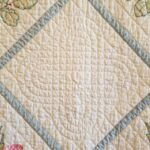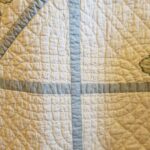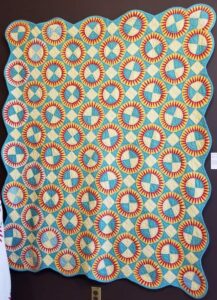
This post follows the first post on the museum and focuses on a few quilts from the museum’s permanent collection.
I really like this Suspension Bridge Variation. The effect of the blocks is gorgeous. The colors are fantastic and the curved border is wonderful. The colors are really great. I love the slightly dull turquoise as a background.
I wonder about making this quilt? I’ll have to add it to the list to think about.
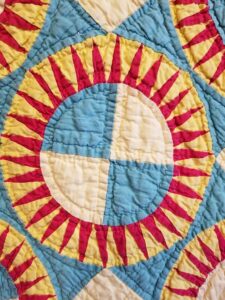
There is a lot of piecing in this quilt. I also notice that the blocks are not really square. Normally, I would expect the spikes to be in separate blocks and make the circle up by setting them together. In the photo, right, you can see that the blue pieces on the outside of the circle are not square. This makes me think that the circles were pieced, then set together with the blue pieces and white pieces between the blocks. LOTS of piecing. I would guess this was hand pieced, but I don’t remember if I looked closely.
It is another quilt by ‘maker unknown’. 🙁 Label your quilts.
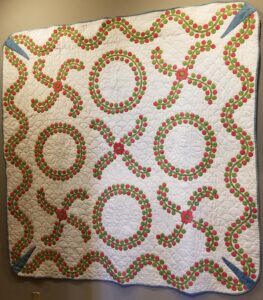
Another interesting quilt I saw was a Circle Applique’ quilt. According to the information, it was made in about 1900, but they think the applique’ may have been done earlier. I really dream about doing applique’, including something like this or a Baltimore Album quilt or one of the fun Piece O’ Cake** designs. As you know, I have done a bit of machine applique’, but it isn’t really something I enjoy on a grand scale. I do love the borders and circles on this. Something about the density of the circles making up the circle applique’ and the borders is really appealing.

I will say that the blue wedges in the corners (see above) are strange. The museum says that “unusual and unexplained wedge shapes of blue chambray fabric inserted int he corners of the borders add to this quilt’s interest.”I wonder if a lesser skilled needleperson wanted to add their mark to an amazing quilt they couldn’t hope to make?
The density of the circle of circles makes the blocks look lush and complete. There is no wispiness here. The maker (again unknown – did I say to label your quilts??) really wanted you to see that circle – or she had a lot of little circles and was proud of her skills.
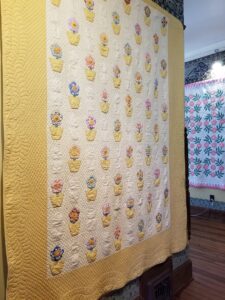
Another quilt that is part of the permanent collection was called Baskets and Flowers by Frances Rieke. It was made in 1930.
The interesting thing about this quilt is that the alternate blocks have a quilted design that mimics the appliqued design. It is like a ghost version of the appliqued blocks.
I also think the quilting in the border is amazing. I love feathered border designs and this one includes a beautiful version. The fabric used was 1930s prints and the information says that each flower head uses a different print. Feedsacks?? No idea.
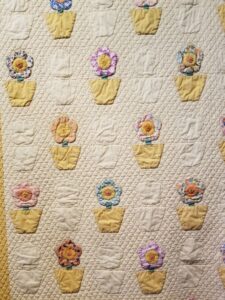
The flowers also include a yo-yo. I am not a huge yo-yo fan, but think they are used to good effect in this quilt. Mostly, I think yo-yo quilts are too delicate, which is why I don’t like them. As embellishments, however, they can be very useful.
I didn’t notice if the fabric in the main part of the flower was different in each block, but they are different in this detail section.
The diamond quilted grid in the background helps the flowers stand out, especially the alternate/quilted only blocks.

There was an improved 9 patch in the museum’s library. I really like that design.
While different, the construction is like my MetroScape quilt. I think this quilt could be made using the same Sew Kind of Wonderful ruler, the Quick Curve Ruler**. The company may even have a pattern, but it will probably be named something different.
In this quilt, the yellow background pieces really make the 9 patches stand out. Also the circles show up really well.

Finally, I saw a quilt that appeared to be machine appliqued. Rosebud Applique’ was made by Elise Eleanor Bryant-Lindeman. The quilt was hanging in the main hallway and was one of the first I saw.
The information on the card said that the quilt was probably made from a kit. It was also described as hand appliqued with a blanket stitch. I don’t agree. The density of the stitching looks like a zigzag stitch to me. Also, the blue strips appear to be machine appliqued on to the top of the quilt with a straight stitch. This makes it possible that Elise was proud of her machine and decided to use it. Of course, I am not a museum curator so I could be wrong.
It is interesting to see that most of these fine quilts have been washed. In this quilt, I found the quilting designs to be quite beautiful. In the third picture above, the curved and woven grid design is very appealing. It is echoed in various related designs in the border, first photo, above, which are also quite beautiful. I am thinking about whether these could be done in machine quilting/ longarming.
Unfortunately, the museum had some perfume or some kind of cleaner that was starting to give me a rash, so we rushed through the last exhibit of contemporary quilts and left. All in all, however, I enjoyed the various quilts and looking at different designs.
**I use affiliate links and may be paid for your purchase of an item when you click on an item link in my post. There is no additional cost to you for clicking or purchasing items I recommend. I appreciate your clicks and purchases as it helps support this blog.


